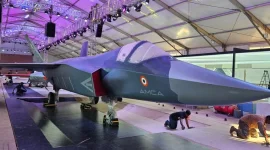- Views: 642
- Replies: 14
The Indian Air Force (IAF) is embarking on an ambitious journey to develop a sixth-generation fighter aircraft, intended to eventually take over from its Su-30MKI fleet by the 2040s.
This strategic initiative is proceeding even as the force maintains a strong focus on the indigenous 5.5-generation Advanced Medium Combat Aircraft (AMCA) program, a senior IAF official has confirmed.
The official highlighted that preliminary studies for this future combat aircraft have commenced. The aim is to clearly outline the specific capabilities and requirements for this advanced jet by early 2030.
A key objective for this next-generation platform is to possess double the operational range and weapons capacity of the AMCA.
The IAF hopes to see a prototype of this sixth-generation fighter ready for evaluation by the year 2040, underscoring a commitment to long-term air power superiority amidst evolving global security challenges.
Su-30MKI Fleet Nears Retirement, Sparking Search for Successor
Currently, the IAF's Su-30MKI fleet, numbering over 260 aircraft as of early 2025, forms the core of its aerial combat strength since its introduction in 2002. However, these aircraft are projected to reach the end of their 30-year operational lifespan by the mid-2030s.Coupled with the geopolitical situation, which includes the presence of advanced aircraft like China’s J-20 and the development of sixth-generation fighter programs by other nations, the IAF is proactively planning for a technologically superior replacement.
The AMCA, which is anticipated to be a 5.5-generation stealth aircraft, is expected to be inducted around 2035 to address more immediate operational needs. Despite this, the IAF is already looking further ahead to an even more advanced successor to the Su-30MKI.
Global Sixth-Generation Programs to Inform Indian Requirements
"We have initiated studies of other sixth-generation programs that have been announced, which will help us formulate our own requirements by early 2030," stated the senior IAF official.International efforts such as the Global Combat Air Programme (GCAP), often referred to by its previous UK-led project name Tempest, the United States' Next Generation Air Dominance (NGAD), and the Franco-German-Spanish Future Combat Air System (FCAS) are likely to serve as important references.
These global programs are focusing on cutting-edge features including the ability for manned aircraft to team with unmanned drones, the integration of directed-energy weapons, superior stealth characteristics, and artificial intelligence (AI) assisted decision-making – all capabilities the IAF is considering for its future fighter.
Significant Capability Leap Envisioned Over Su-30MKI and AMCA
The Su-30MKI, classified as a heavy fighter, has an approximate combat range of 1,500 kilometres, which can be extended to 3,000 kilometres with in-flight refuelling. It is capable of carrying up to 8 tons of armaments, including various air-to-air missiles, precision-guided bombs, and anti-ship missiles.However, the IAF official stressed the necessity for a substantial enhancement in performance for its sixth-generation aircraft.
"We need to define what capabilities we want in a next-generation fighter that will replace the Su-30MKI. It might need to have twice the range and weapons carrying capacity of the AMCA," the official elaborated.
If realised, a combat range of 3,000 kilometres without refuelling and a weapons payload capacity of 13 tons would make the IAF’s sixth-generation fighter a highly potent asset.
Such specifications would enable it to conduct deep penetration strike missions throughout the Indo-Pacific region and maintain dominance in contested airspaces.
This would provide a significant counter to potential adversaries, including China, whose J-20 fighter reportedly has a range of about 2,000 kilometres and an 11-ton payload.
The increased payload would also facilitate the use of next-generation weaponry, such as hypersonic missiles and laser-based systems, aligning with emerging trends in advanced fighter aircraft design.
Ambitious Timeline and Technological Hurdles
Meeting these advanced objectives by 2040 will necessitate considerable technological breakthroughs and meticulous strategic planning. The IAF's proposed timeline—to define specific requirements by 2030 and develop a prototype by 2040—is comparable to global sixth-generation programs, many of which are targeting operational deployment by the mid-2030s.However, India faces distinct challenges, notably in the area of aero-engine development, which has historically been a critical constraint for its indigenous aircraft programs like the Tejas Light Combat Aircraft and the upcoming AMCA. Successful development of a powerful and reliable engine will be paramount for the sixth-generation project.
Advanced Technologies for Future Air Combat
Beyond a powerful propulsion system, the IAF’s future sixth-generation fighter will require the integration of numerous advanced technologies.These include adaptive stealth capabilities (which could involve materials or systems that actively alter the aircraft's signature), AI-driven autonomous functions for teaming with unmanned "loyal wingman" drones, and sophisticated thermal management systems to handle the heat generated by potential directed-energy weapons.
The aircraft designed to replace the Su-30MKI will also need next-generation avionics, incorporating AI-based sensor fusion for a comprehensive understanding of the battlespace and 360-degree situational awareness to effectively counter sophisticated threats like hypersonic missiles and coordinated drone swarms.
Strategic Imperative in a Modernising Asia
The IAF’s forward planning for a sixth-generation fighter is a reflection of the dynamic strategic environment in Asia.China's ongoing rapid military modernisation, which includes the operational J-20 stealth fighter and reported work on its own future combat aircraft, presents a significant long-term consideration for Indian defence planners.
Concurrently, major global powers such as the United States and its allies are making substantial investments in their own next-generation fighter capabilities, with the US NGAD program intended to succeed the F-22 Raptor by the late 2030s.
India’s pursuit of sixth-generation fighter technology is therefore driven by the dual needs of ensuring effective deterrence and maintaining its position within the global aerospace and defence hierarchy.



